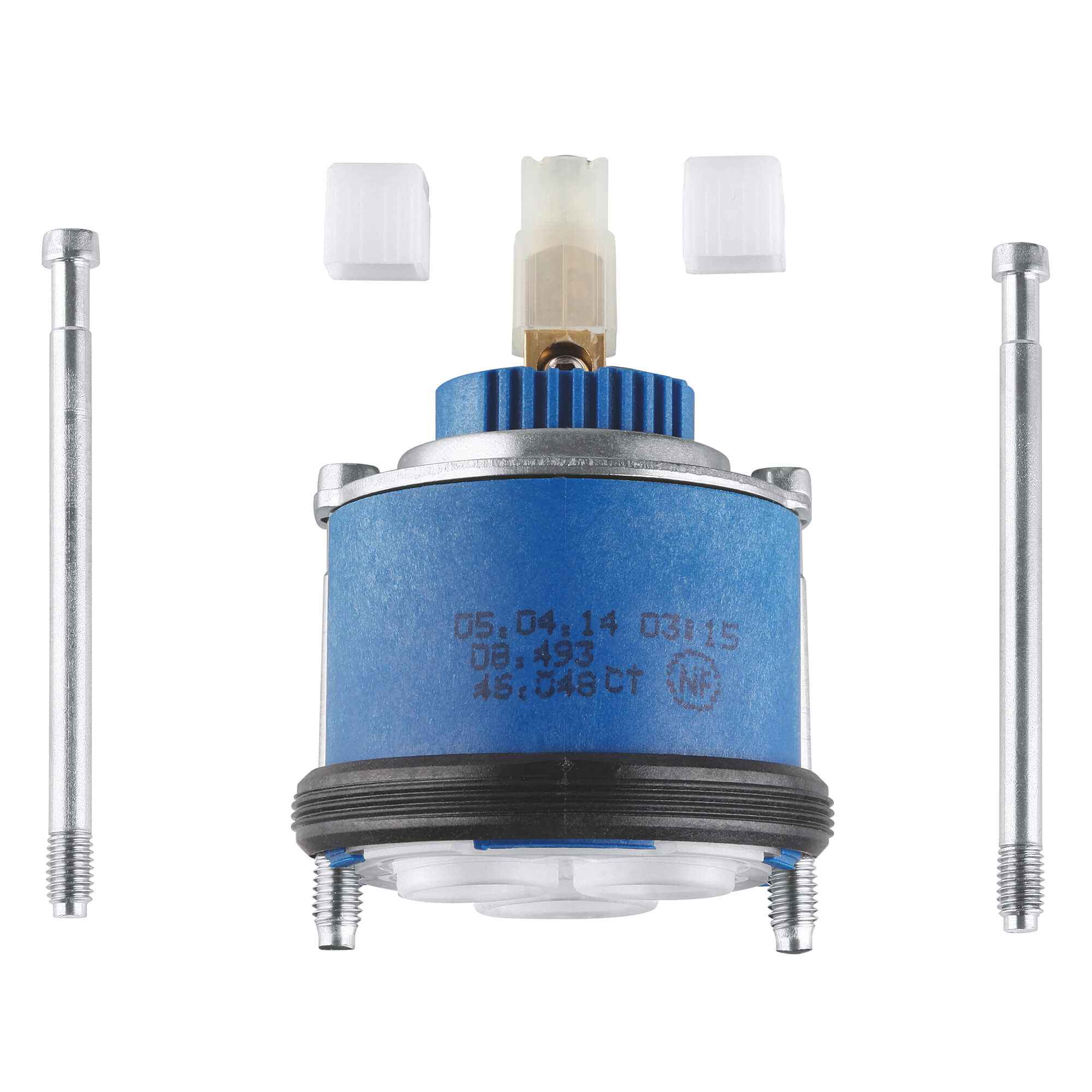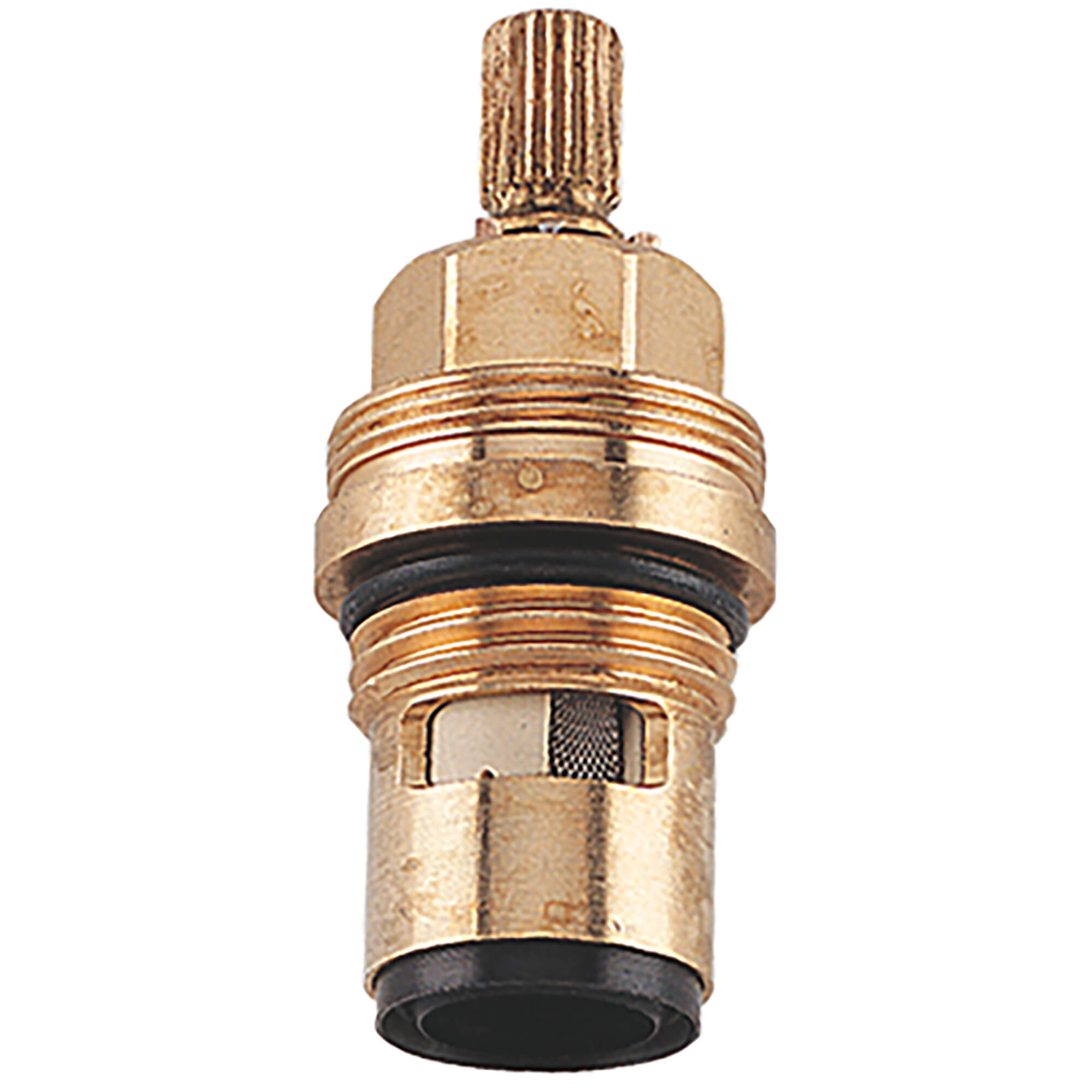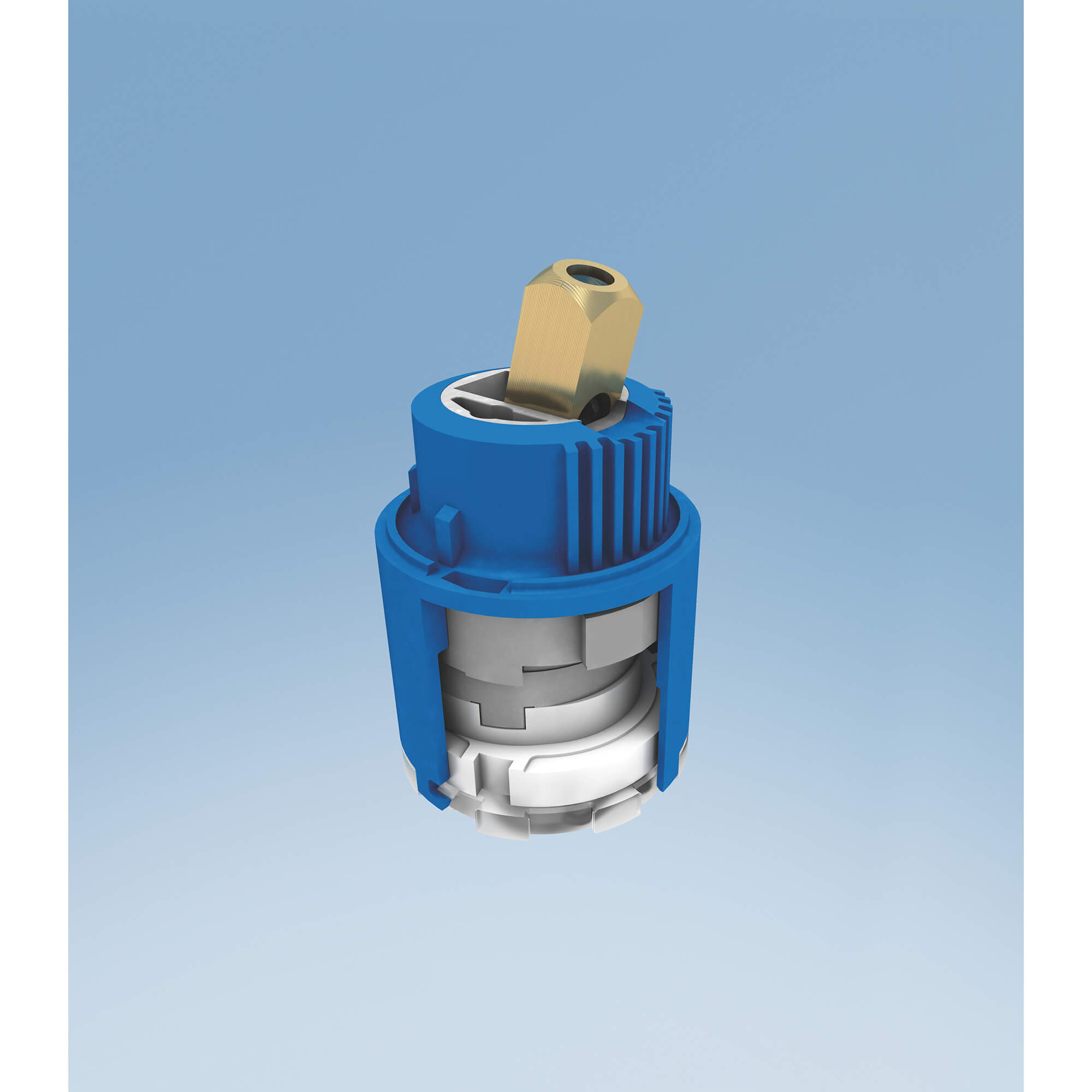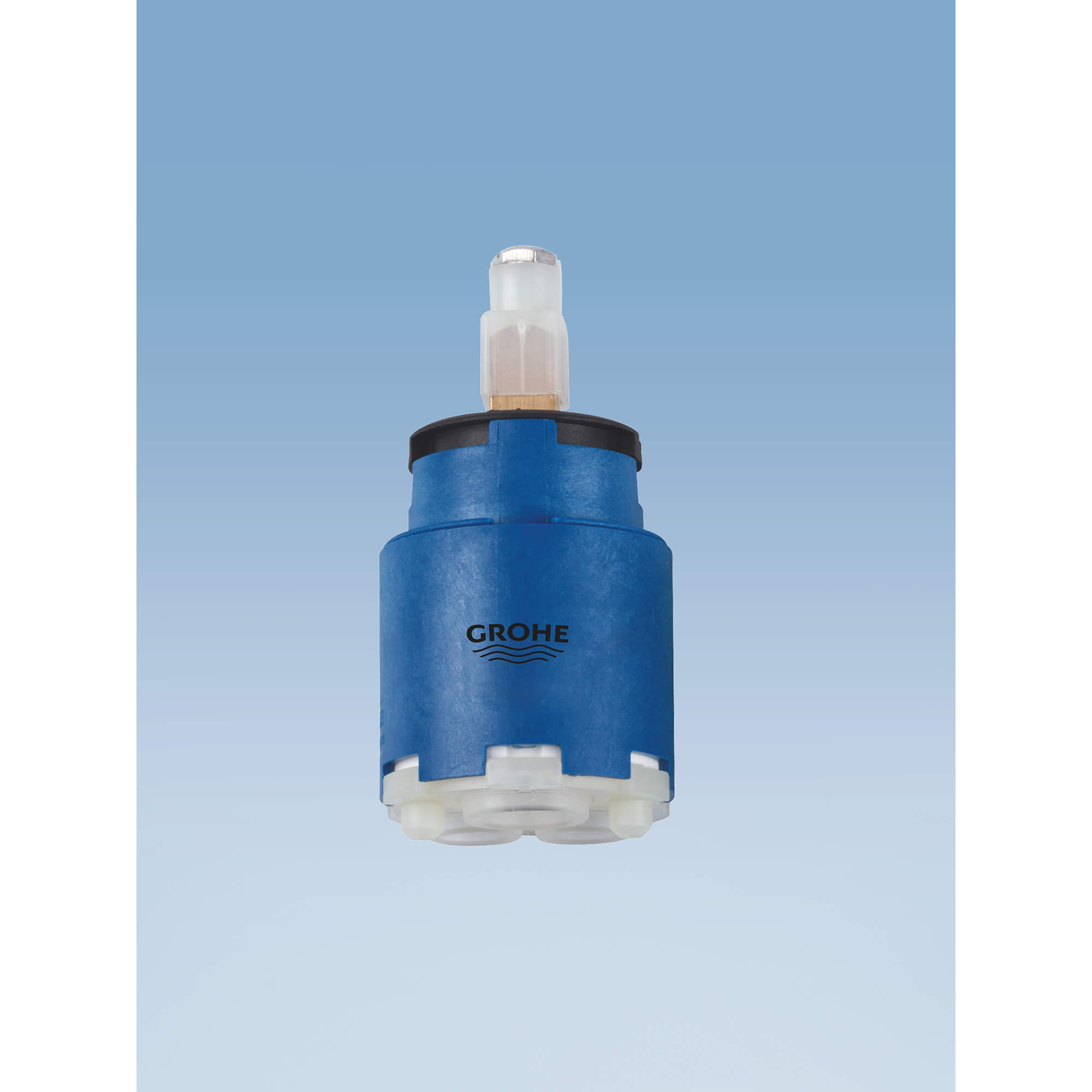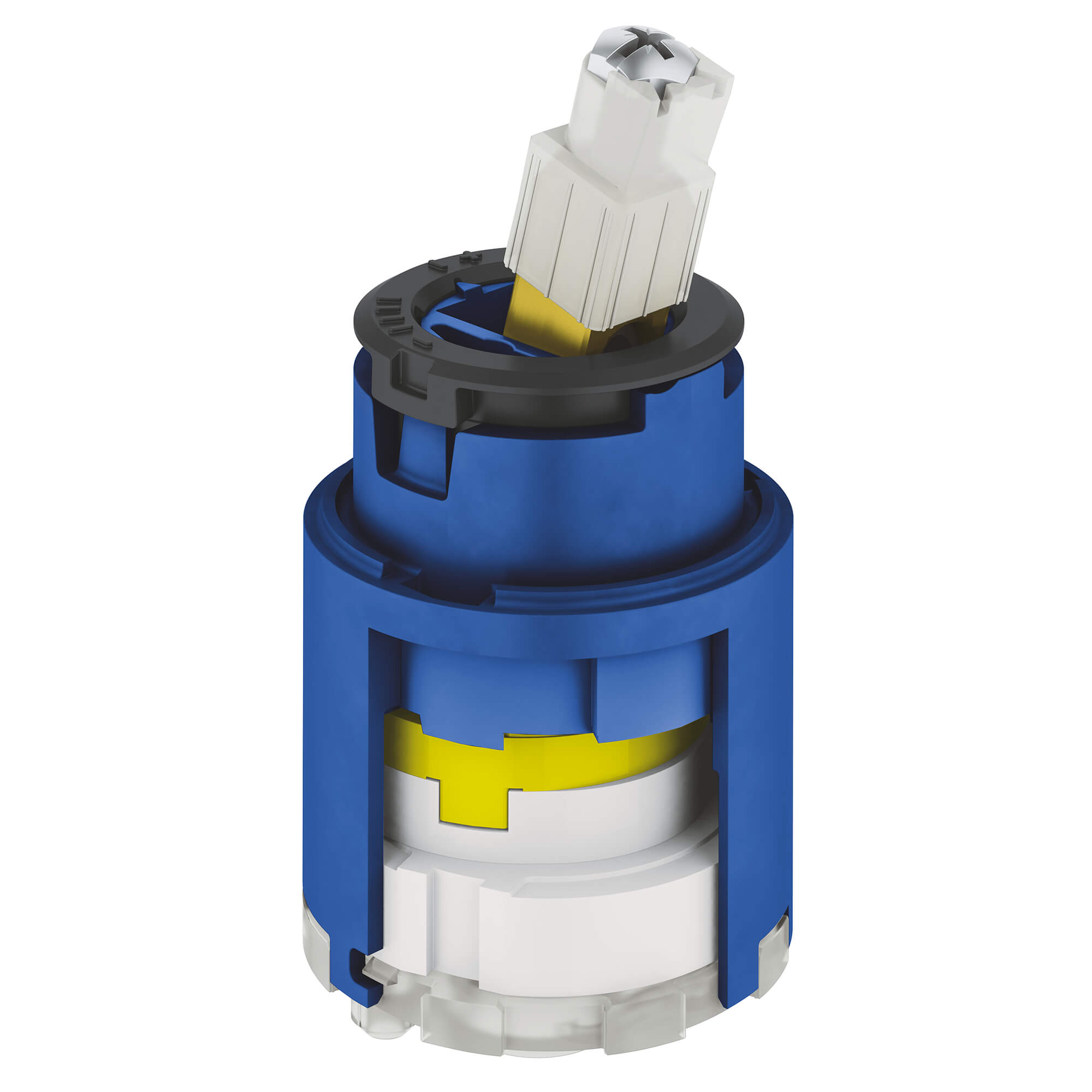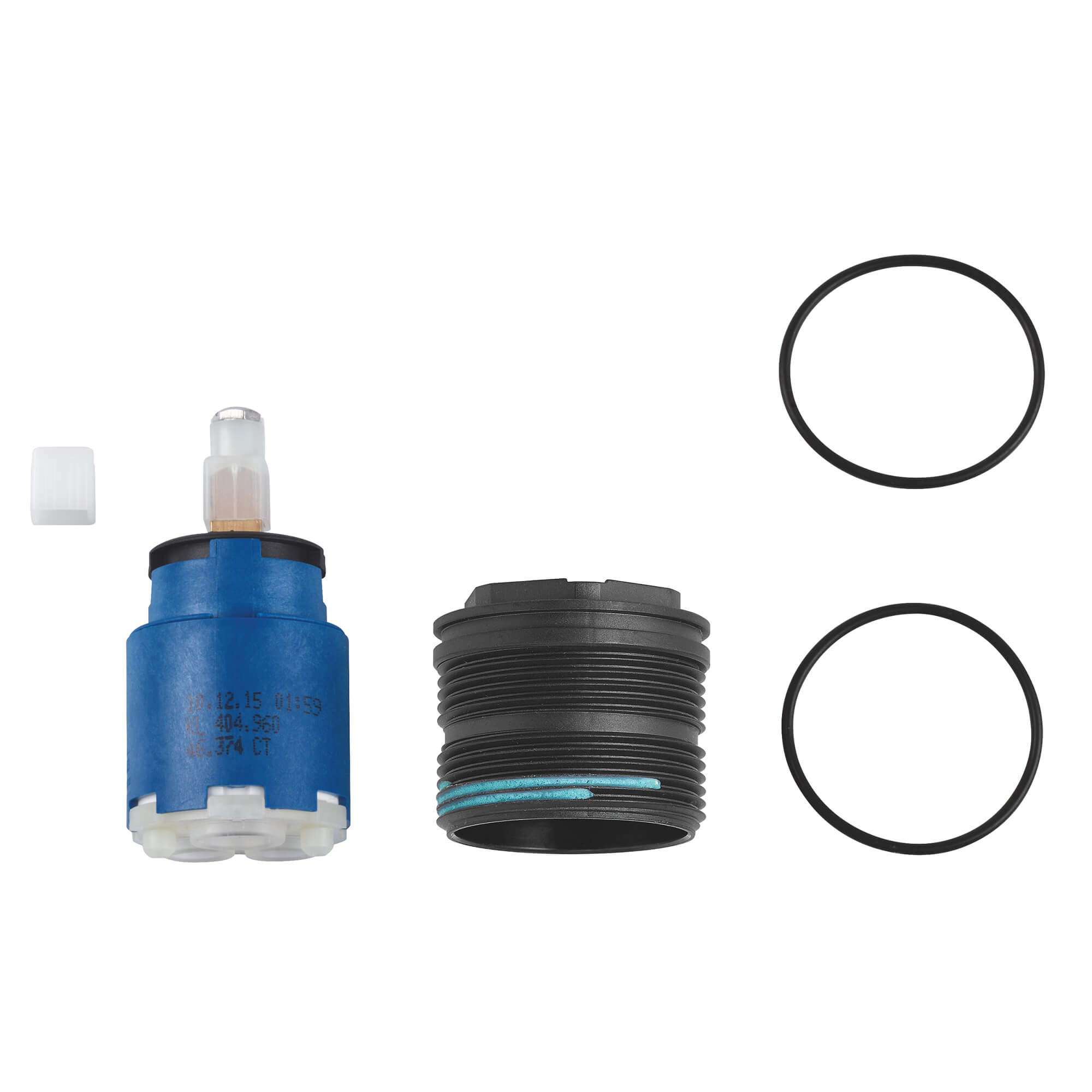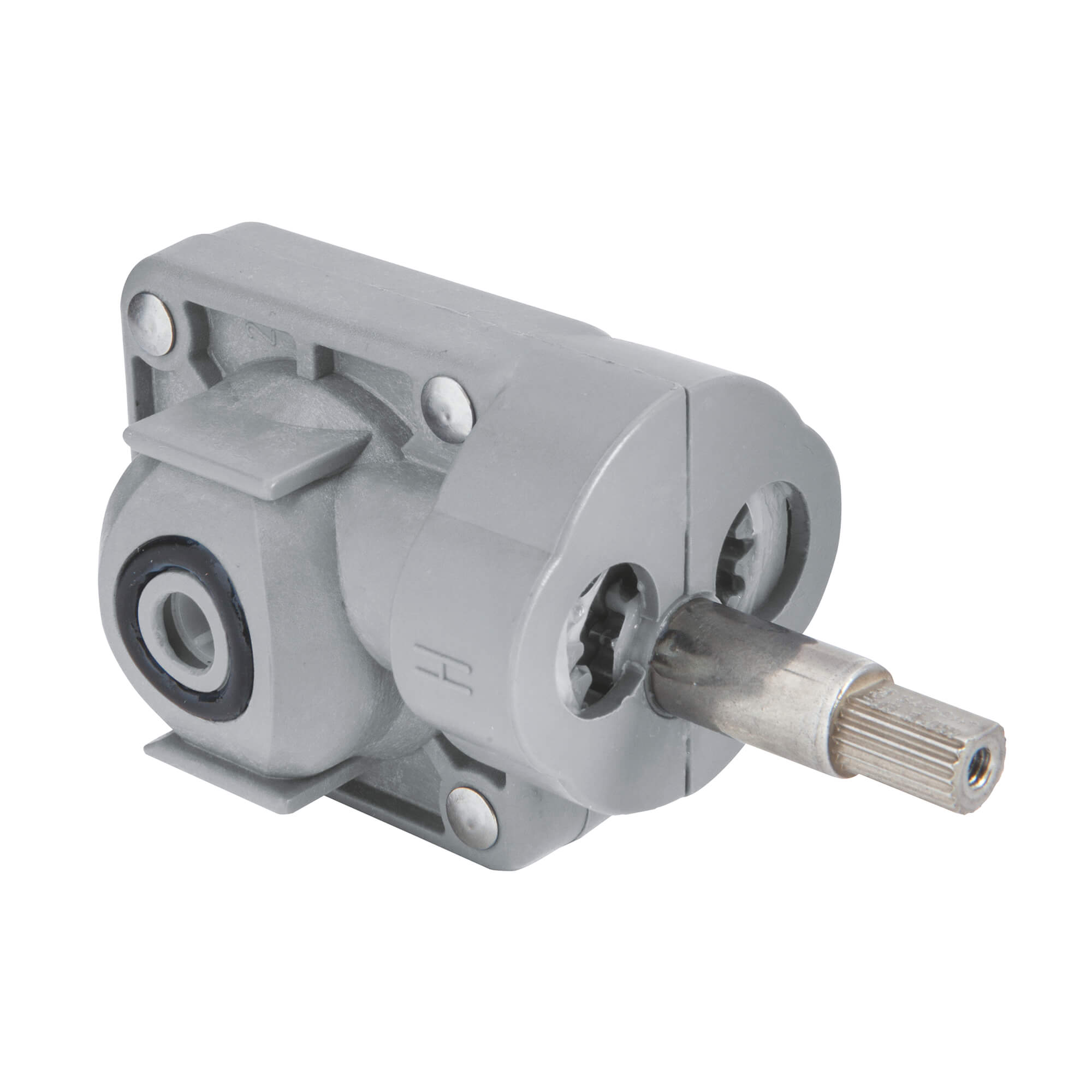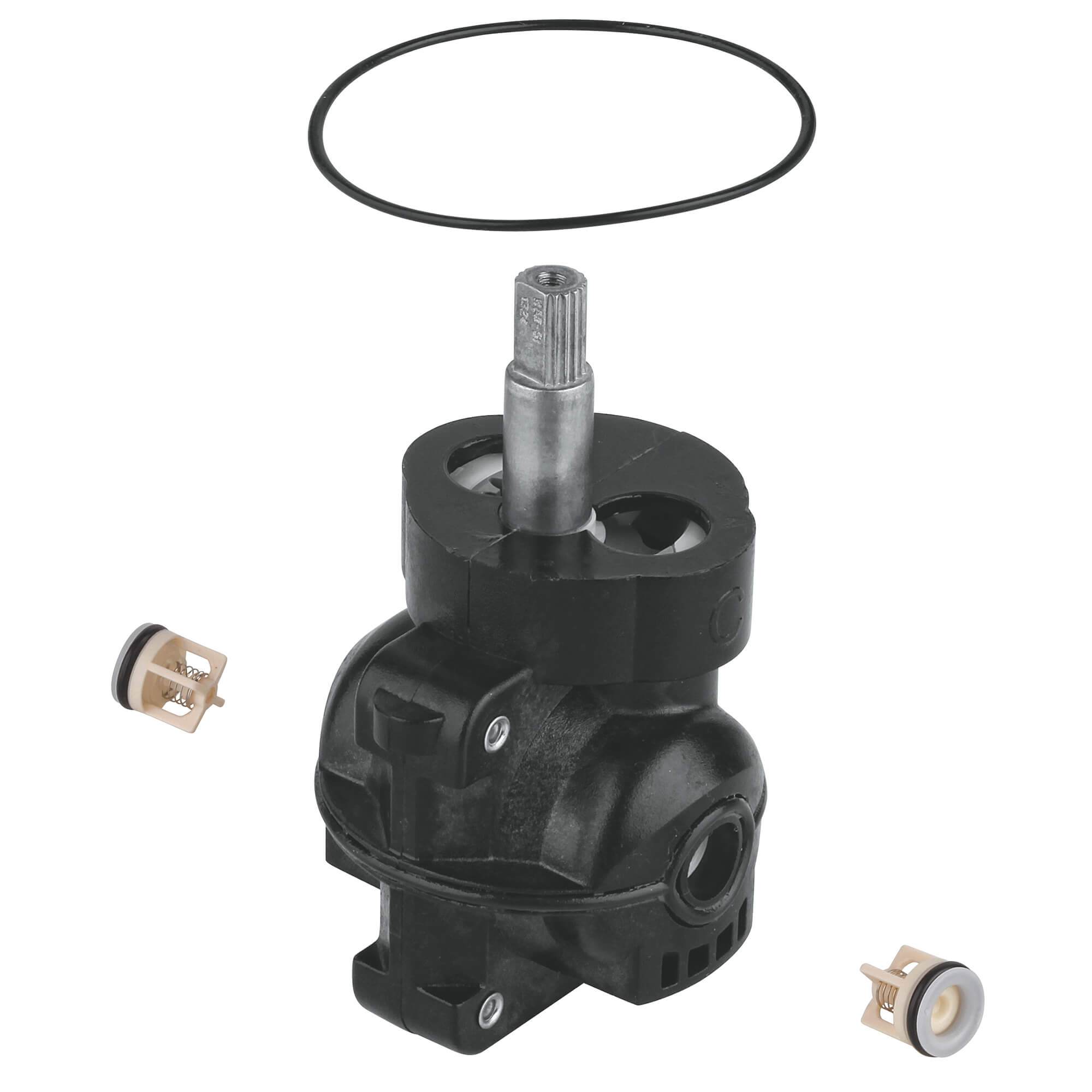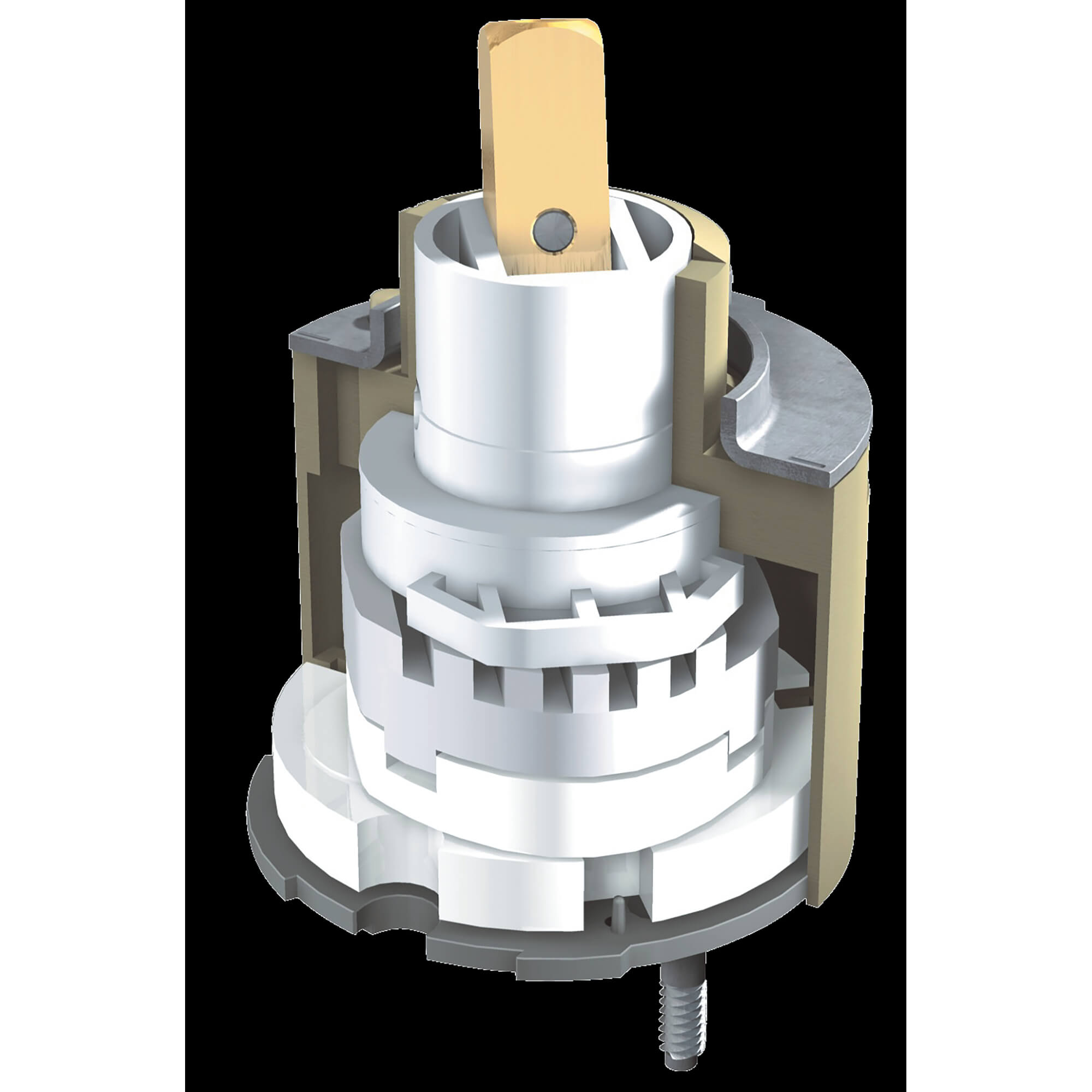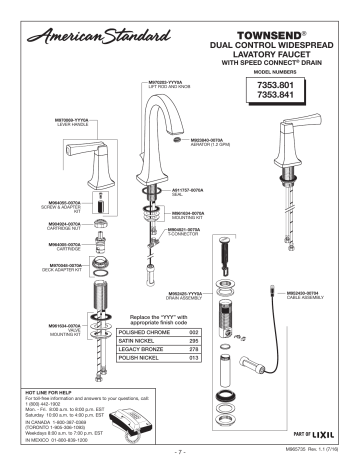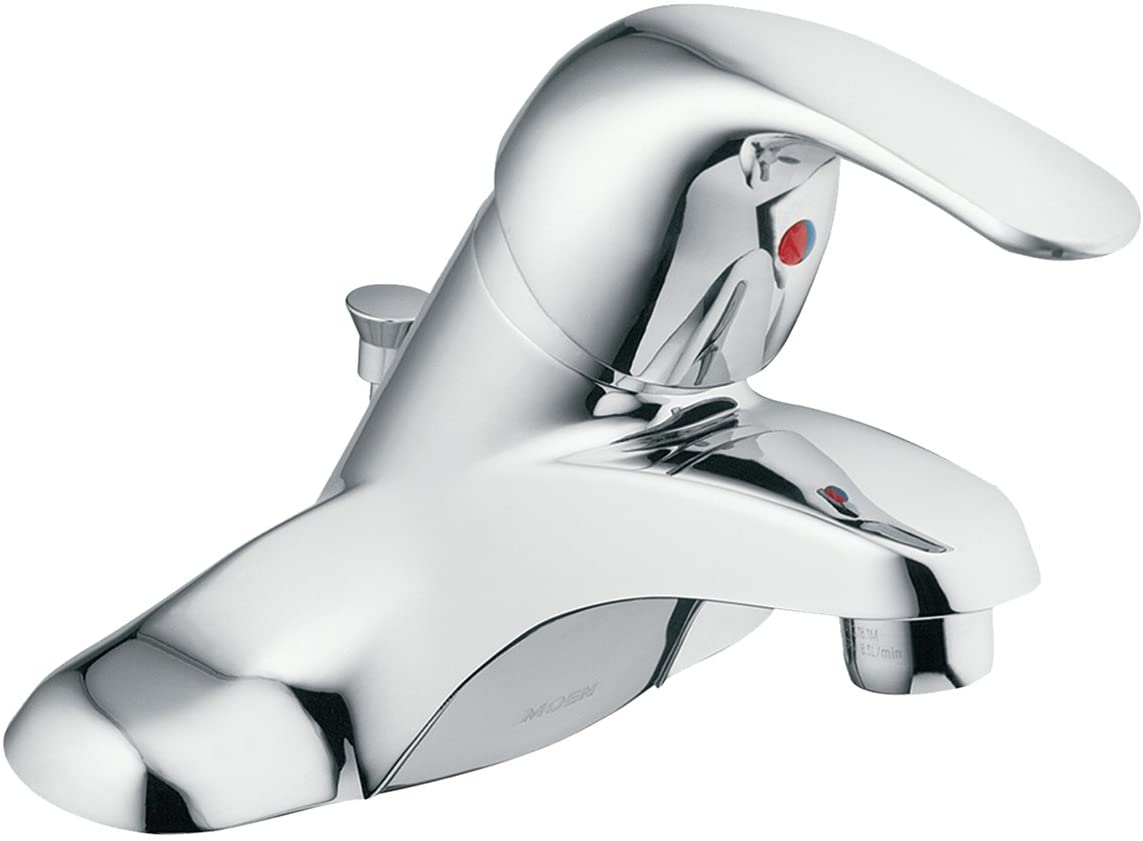The Role of a Grohe Bathroom Faucet Cartridge
Grohe bathroom faucet cartridges serve as the heart of the faucet, controlling the flow and temperature of the water. These small but crucial components play a significant role in ensuring smooth operation and optimal performance of your Grohe faucet. Let’s discuss the importance of Grohe bathroom faucet cartridges:
- Regulating Water Flow: Grohe faucet cartridges regulate the flow of water by controlling the opening and closing of the faucet’s water channels. When you turn the faucet handle, the cartridge moves inside the faucet body, adjusting the flow of water to meet your desired water pressure. This precise control allows you to customize the flow rate according to your needs, whether you’re washing your hands, filling a sink, or rinsing dishes.
- Maintaining Water Temperature: In addition to regulating water flow, Grohe faucet cartridges also control the temperature of the water by mixing hot and cold water from the supply lines. The cartridge features internal components that adjust the ratio of hot and cold water to achieve the desired temperature set by the faucet handle. This ensures a consistent and comfortable water temperature every time you use the faucet, enhancing your overall bathing and grooming experience.
- Ensuring Smooth Operation: Grohe bathroom faucet cartridges are designed for durability and reliability, providing smooth and effortless operation for years to come. The cartridges are engineered with precision to minimize friction and wear, allowing the faucet handle to move easily and smoothly without sticking or jamming. This ensures a seamless user experience and reduces the risk of leaks or malfunctions that can disrupt your daily routine.
- Preventing Water Waste: By controlling the flow and temperature of the water, Grohe faucet cartridges help prevent water waste and promote environmental sustainability. The precise control provided by the cartridge allows you to use only the amount of water you need for each task, reducing unnecessary water consumption and conserving valuable resources. This not only helps lower your water bills but also reduces your ecological footprint, making your bathroom more eco-friendly.
- Enhancing User Experience: Ultimately, Grohe bathroom faucet cartridges play a vital role in enhancing your overall user experience in the bathroom. With their reliable performance, smooth operation, and precise control of water flow and temperature, these cartridges ensure that you can enjoy a comfortable and convenient bathing and grooming experience every time you use your Grohe faucet. Whether you’re taking a relaxing shower, washing your hands, or brushing your teeth, you can trust that your Grohe faucet cartridge will deliver consistent and reliable performance to meet your needs.
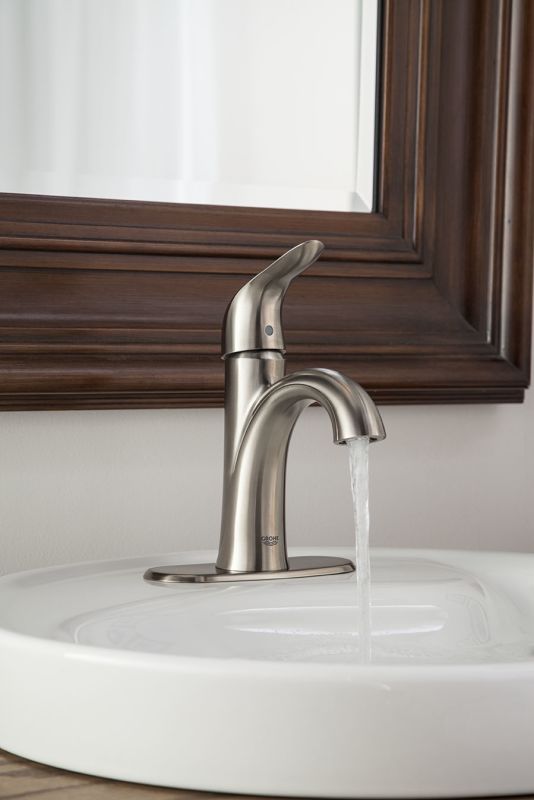
Components and Functionality of Grohe Bathroom Faucet Cartridges
Grohe bathroom faucet cartridges are sophisticated components that play a crucial role in the functionality and performance of Grohe faucets. Understanding the inner workings and components of these cartridges can help you better appreciate their importance and troubleshoot any issues that may arise. Let’s explore the components and functionality of Grohe bathroom faucet cartridges:
Ceramic Discs: One of the key components of Grohe faucet cartridges is ceramic discs, which are precision-engineered discs made of durable ceramic material. These discs control the flow and temperature of the water by sliding against each other to open or close the water channels. The smooth surface of the ceramic discs minimizes friction and wear, ensuring long-lasting performance and reliability.
Seals and O-Rings: Grohe faucet cartridges feature rubber seals and O-rings that create watertight seals between the cartridge and the faucet body. These seals prevent water from leaking out of the faucet and ensure that the water flows smoothly and efficiently through the cartridge. Over time, seals and O-rings may wear out or deteriorate, leading to leaks or drips. Regular inspection and replacement of these components can help maintain the integrity of the cartridge and prevent water damage to your bathroom.
Temperature Limiter: Many Grohe faucet cartridges are equipped with a temperature limiter mechanism that allows you to control the maximum temperature of the water to prevent scalding. The temperature limiter can be adjusted to limit the movement of the faucet handle, preventing it from turning too far to the hot side and reducing the risk of accidental burns. This feature is especially important for households with young children or elderly individuals who may be more susceptible to burns from hot water.
Flow Control Mechanism: Grohe faucet cartridges include a flow control mechanism that regulates the flow rate of the water to meet your desired pressure preferences. The mechanism may consist of adjustable discs or valves that restrict or allow water to flow through the cartridge, depending on the position of the faucet handle. By adjusting the flow control mechanism, you can customize the water pressure to suit your needs, whether you prefer a gentle stream for washing delicate items or a strong jet for rinsing.
Integrated Filters: Some Grohe faucet cartridges feature integrated filters or screens that help remove impurities and sediment from the water, ensuring clean and clear water for bathing and grooming. These filters trap particles such as dirt, sand, and rust that may be present in the water supply, preventing them from clogging the faucet and affecting water quality. Regular cleaning and maintenance of the filters can help prolong the life of the cartridge and maintain optimal water flow and performance.
Anti-Scald Technology: Grohe faucet cartridges may also incorporate anti-scald technology, such as thermostatic mixing valves or pressure-balancing mechanisms, to prevent sudden temperature fluctuations and maintain a consistent water temperature. These features help protect against scalding injuries by automatically adjusting the flow of hot and cold water to maintain a safe and comfortable temperature range. Anti-scald technology is especially important for households with children or elderly individuals who may be at greater risk of burns from hot water.
Common Issues and Troubleshooting Tips
Grohe bathroom faucet cartridges are designed for durability and reliability, but like any plumbing component, they can experience issues over time due to wear and tear, mineral deposits, or other factors. Knowing how to identify and troubleshoot common issues with Grohe faucet cartridges can help you resolve problems quickly and efficiently. Below are some common issues and troubleshooting tips for Grohe bathroom faucet cartridges:
Leaks or Drips: One of the most common issues with Grohe faucet cartridges is leaks or drips from the faucet spout. This can occur due to worn seals, O-rings, or ceramic discs within the cartridge. To troubleshoot this issue, first, turn off the water supply to the faucet and disassemble the faucet handle to access the cartridge. Inspect the seals, O-rings, and ceramic discs for signs of wear or damage, and replace any components that appear worn or deteriorated. Reassemble the faucet handle and turn the water supply back on to see if the leak has been resolved.
Low Water Pressure: Another common issue with Grohe faucet cartridges is low water pressure, which can be caused by a clogged cartridge or water supply line, mineral deposits, or a faulty flow control mechanism. To troubleshoot this issue, first, check the aerator on the faucet spout for clogs or debris and clean or replace it as needed. If the water pressure is still low, remove the cartridge from the faucet and inspect it for mineral buildup or debris. Clean the cartridge thoroughly with vinegar or a descaling solution to remove any deposits that may be restricting water flow. Reinstall the cartridge and test the water pressure to see if it has improved.
Uneven Temperature: If you’re experiencing uneven temperature control or fluctuations in water temperature with your Grohe faucet cartridge, it may indicate a problem with the temperature limiter mechanism or the cartridge itself. To troubleshoot this issue, first, check the temperature limiter setting on the cartridge to ensure it is properly adjusted to your desired temperature range. If the temperature is still inconsistent, remove the cartridge from the faucet and inspect it for damage or wear. Replace the cartridge if necessary, and adjust the temperature limiter as needed to achieve a consistent water temperature.
Sticky or Stiff Handle: A sticky or stiff handle on your Grohe faucet may indicate a problem with the cartridge or the faucet handle mechanism. To troubleshoot this issue, first, check for any obstructions or debris inside the faucet handle that may be causing it to stick. Clean the handle mechanism thoroughly and lubricate any moving parts with silicone grease or plumber’s lubricant to improve smoothness and operation. If the handle is still sticky or stiff, remove the cartridge from the faucet and inspect it for signs of wear or damage. Replace the cartridge if necessary, and reassemble the faucet handle to test for improved operation.
Noisy Operation: If your Grohe faucet cartridge is making noise during operation, such as squeaking, grinding, or rattling sounds, it may indicate a problem with the cartridge or the faucet components. To troubleshoot this issue, first, check for loose or damaged parts inside the faucet handle that may be causing the noise. Tighten any loose screws or fasteners and replace any damaged components as needed. If the noise persists, remove the cartridge from the faucet and inspect it for signs of wear or damage. Replace the cartridge if necessary, and reinstall it securely to see if the noise has been resolved.
Difficulty Adjusting Temperature or Flow: If you’re having difficulty adjusting the temperature or flow of water with your Grohe faucet cartridge, it may indicate a problem with the cartridge mechanism or internal components. To troubleshoot this issue, first, check for any obstructions or debris inside the faucet handle that may be preventing smooth operation. Clean the handle mechanism thoroughly and lubricate any moving parts as needed to improve adjustability. If the problem persists, remove the cartridge from the faucet and inspect it for signs of wear or damage. Replace the cartridge if necessary, and reassemble the faucet handle to test for improved functionality.
Replacement and Maintenance Tips
Servicing and maintaining your Grohe bathroom faucet cartridge is essential for ensuring optimal performance and longevity of your faucet. Regular maintenance can help prevent issues such as leaks, drips, low water pressure, and temperature fluctuations, saving you time and money on repairs and replacements. Let’s see how to service and maintain your Grohe bathroom faucet cartridge:
Inspect Regularly: To keep your Grohe faucet cartridge in top condition, perform regular inspections to check for signs of wear, damage, or mineral buildup. Remove the faucet handle and inspect the cartridge for any visible issues, such as worn seals, O-rings, or ceramic discs, as well as mineral deposits or debris that may be affecting performance. If you notice any problems during the inspection, take corrective action promptly to prevent further damage and ensure the continued reliability of your faucet.
Clean Thoroughly: Over time, mineral deposits, sediment, and debris can accumulate inside the Grohe faucet cartridge, affecting water flow and performance. To remove these deposits and restore optimal functionality, clean the cartridge thoroughly with vinegar or a descaling solution. Soak the cartridge in the cleaning solution for several hours to dissolve mineral buildup, then scrub it gently with a soft-bristled brush to remove any remaining debris. Rinse the cartridge thoroughly with clean water and reinstall it in the faucet to complete the cleaning process.
Replace Seals and O-Rings: Seals and O-rings are critical components of the Grohe faucet cartridge that create watertight seals and prevent leaks. Over time, these seals may become worn or deteriorated, leading to leaks or drips from the faucet spout. To prevent water damage and maintain the integrity of your faucet, inspect the seals and O-rings regularly and replace them as needed. Be sure to use high-quality replacement parts that are compatible with your Grohe faucet model to ensure a proper fit and reliable performance.
Adjust Temperature Limiter: If you’re experiencing issues with temperature control or fluctuations in water temperature with your Grohe faucet cartridge, adjusting the temperature limiter mechanism can help resolve the problem. Locate the temperature limiter setting on the cartridge and adjust it to your desired temperature range using a flathead screwdriver. Be sure to follow the manufacturer’s instructions for adjusting the temperature limiter and test the water temperature to ensure that it falls within the desired range.
Lubricate Moving Parts: To ensure smooth and effortless operation of your Grohe faucet cartridge, lubricate any moving parts, such as the handle mechanism and ceramic discs, with silicone grease or plumber’s lubricant. Apply a small amount of lubricant to the moving parts and work it into the mechanism to reduce friction and wear. This will help prolong the life of the cartridge and maintain the smooth operation of your faucet for years to come.
Replace When Necessary: Despite regular maintenance and care, Grohe faucet cartridges may eventually wear out or become damaged over time, especially in high-traffic areas or hard water environments. If you notice persistent issues with your faucet, such as leaks, drips, or difficulty adjusting temperature or flow, it may be time to replace the cartridge. Consult the manufacturer’s instructions or seek professional assistance to ensure that you select the correct replacement cartridge for your Grohe faucet model and install it properly for optimal performance.
Features to Consider When Choosing a Grohe Faucet Cartridge
When it comes to upgrading your bathroom experience, choosing the right Grohe faucet cartridge can make all the difference in functionality, performance, and style. With a wide range of features and options available, selecting the perfect cartridge for your Grohe faucet can enhance your bathing and grooming experience and add convenience and luxury to your daily routine. Let’s discuss some key features to consider when choosing a Grohe faucet cartridge:
Temperature Control: One of the most important features to consider when choosing a Grohe faucet cartridge is temperature control. Look for cartridges with precise temperature control mechanisms that allow you to adjust the water temperature to your desired level with ease. Some cartridges may include thermostatic mixing valves or pressure-balancing mechanisms that maintain a consistent temperature range, preventing sudden fluctuations and ensuring a comfortable bathing experience.
Water Flow: Another important consideration is water flow, as it directly impacts the performance and functionality of your faucet. Choose cartridges with adjustable flow control mechanisms that allow you to customize the water pressure to suit your needs. Look for cartridges with aerated or laminar flow options that provide a smooth and steady stream of water, reducing splashing and minimizing water waste. Consider your household’s water usage habits and preferences when selecting a cartridge with the appropriate flow rate for your needs.
Durability and Reliability: When investing in a Grohe faucet cartridge, prioritize durability and reliability to ensure long-lasting performance and functionality. Choose cartridges made from high-quality materials, such as ceramic discs, brass, or stainless steel, that are resistant to corrosion, wear, and mineral buildup. Look for cartridges with a reputation for reliability and longevity, backed by warranties or guarantees from the manufacturer, to ensure peace of mind and confidence in your purchase.
Easy Installation and Maintenance: Opt for Grohe faucet cartridges that are designed for easy installation and maintenance to simplify the process and minimize hassle. Look for cartridges with user-friendly features, such as tool-free installation, quick-connect fittings, and accessible components, that make it easy to install, remove, and service as needed. Choose cartridges with replaceable seals, O-rings, and ceramic discs that allow for convenient repairs and replacements without the need for specialized tools or expertise.
Compatibility: Ensure compatibility between the Grohe faucet cartridge and your existing faucet model to avoid compatibility issues and ensure a proper fit and function. Check the specifications and dimensions of the cartridge to ensure that it matches the requirements of your faucet, including the mounting type, handle configuration, and water supply connections. If you’re unsure about compatibility, consult the manufacturer’s instructions or seek guidance from a plumbing professional to ensure a seamless installation and optimal performance.
Style and Design: Finally, consider the style and design of the Grohe faucet cartridge to complement your bathroom decor and enhance the overall aesthetic of your space. Choose cartridges with sleek and modern designs that coordinate with your existing fixtures and accessories for a cohesive look. Look for cartridges with a variety of finishes and styles, such as chrome, brushed nickel, or matte black, to match your taste and preferences. Consider the shape, size, and handle design of the cartridge to ensure that it complements the overall design scheme of your bathroom and adds a touch of elegance and sophistication to your space.
Grohe Ceramic Cartridges
Cartridge
Cartridge
Cartridge
Grohe-46.048.000-Single-Handle-Mixing-Valve-Ceramic-Cartridge
Pressure Balance Valve Cartridge
Grohe-07.146.000-Cartridge-Sink-Lavatory-Faucet—Chrome
Pressure Balance Valve Cartridge
Cartridge
Related Posts:
- Bathroom Faucet Design Ideas
- How To Fix A Broken Bathroom Faucet Handle?
- Rv Bathroom Faucet With Shower
- Bathroom Faucet Drain Parts
- Price Pfister Single Handle Bathroom Faucet
- Installing Bathroom Faucet Fixture
- Bathroom Faucet Dimensions
- Repair Bathroom Faucet Handle
- 6 Inch Centerset Bathroom Faucet
- Moen Bathroom Faucets Kingsley
